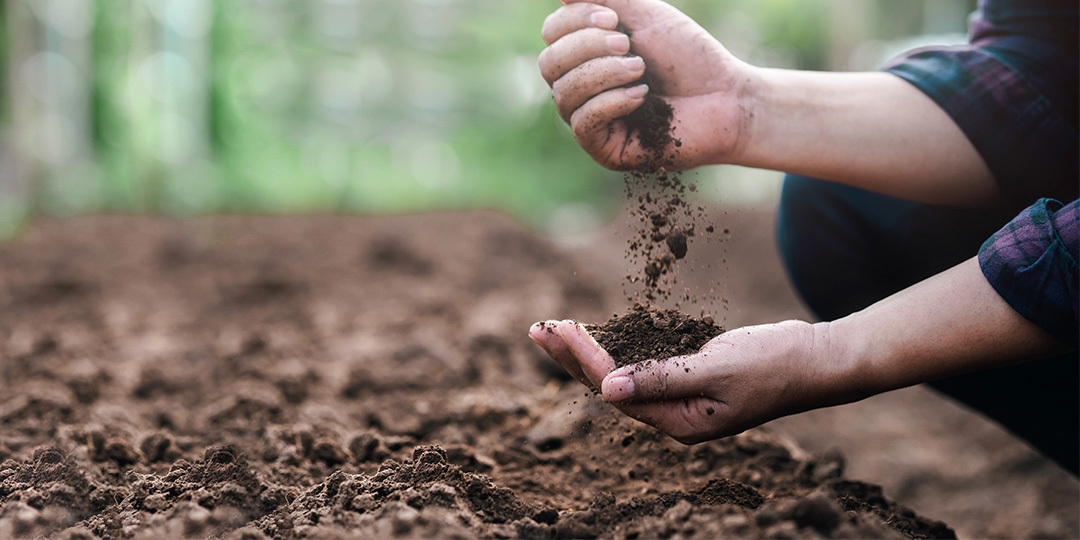Tree enthusiasts that dig deeper for ways to make their trees and yard as healthy as possible have probably run across the question before: What type of soil is best for growing plants? The answer, like so many answers in tree care, is that it depends. In this case, your climate and the kind of tree you want to plant affect how well the saplings you plant will grow. Here’s how to choose the best trees for the soil you already have.
What Are Soil Types?
Soil types describe the texture of the soil you’re working with based on its makeup. They’re characterized by their proportions of three particles: sand, silt, and clay. A soil made of about equal parts of these particles is called loam. Soil types get more granular (pun intended) with mixed types like silty clay or loamy sand, but we’ll focus on the four big categories today.
What Type of Soil Do I Have? How to Determine Soil Type
Different regions are more likely to have certain soil types based on available materials, climate, erosion, slope, and other factors. For a general idea, you can access historical soil surveys in your state. To get a clearer picture of what’s in your yard, perform a simple test using a clear glass jar with a lid, dish soap, and water.
- Scoop a soil sample from your yard where you wish to plant. Pick out grass, pebbles, and sticks.
- Fill your jar about a third of the way with dirt.
- Fill the rest of the jar with water and a few drops of dish soap.
- Screw the lid on your jar tightly and shake it vigorously for three minutes.
- Place the jar where it won’t be disturbed for at least 24 hours.
When your sample has settled completely, it should separate into three distinct layers. Sand will be on the bottom, silt in the middle, and clay on the top. The largest layer shows which particle dominates the soil in your yard. If two layers are equal, you have a mixed soil type, and three even layers mean loamy soil.
Which Type of Soil Holds the Most Water?
Clay soil holds water the longest, draining slowly and sometimes getting in the way of root growth. Sandy soil has the opposite problem, draining water very quickly. Silt and loam have the best natural drainage balance.
Choosing Your Trees: Native Always Wins
When picking the trees that will thrive in your yard, choosing a tree native to your area is a safe bet. These trees have evolved to grow in the soil types prevalent in the area. You can also choose based on more general guidelines on which trees thrive in each type of soil.
Trees that Grow in Clay Soil
Trees that grow in wetlands or near riverbanks often grow in clay soil. Choose from clay-loving trees like:
- Red or Silver Maple
- River Birch
- Hawthorne
- European Larch
- Cottonwood
- Swamp White Oak
- Linden
- American Elm
- Blue Elder
- Mulberry
- Sweetgum
- Weeping Willow
- Sycamore
- Crabapple
- Sweet Bay Magnolia
Clay soil has the highest water retention rate and poor aeration. You’ll need to watch out for problems with over-watering, such as limp leaves or mold around the trunk. Professional intervention can help trees recover from diseases introduced through overwatering.
What Types of Trees Grow Well in Sandy Soil?
Evergreens tend to flourish the best in sandy soil. Try planting:
- Jack Pine
- Red Pine
- White Pine
- Scotch Pine
- Mugo Pine
- White Oak
- Northern Pin Oak
- Black Oak
- Juniper
- Poplar
- European Larch
- White Cedar
Sandy soil has low water retention, with high drainage and aeration. It’s also the most likely to lose essential plant nutrients to runoff. Even native plants can benefit from a regularly scheduled fertilization program. We provide seasonal or custom plans to combat nutrient deficiencies. Trees in sandy soil will also struggle the most during a drought since the soil dries out so quickly.
Trees that Grow in Loam Soil or Silty Soil
Loam and silt-heavy soil are the kindest to plants, with the widest variety of plants thriving in them. Choose from popular backyard species, including:
- Red Oak
- White or Green Ash
- Sugar or Red Maple
- Norway Spruce
- Colorado Blue Spruce
- Fraser Fir
- Douglas Fir
- Dogwoods
- Weeping Cherry
- Birch
- Aspen
- Beech
- Most Maples
- Most Oaks
- Fruit Trees
Loam and high-silt soils have the same strong balance of drainage, aeration, and nutrient retention. This doesn’t mean they don’t need care, however.
Care for Your Trees Throughout Their Lives
A professional arborist from Monster Tree Service can tell you what trees will flourish in your soil with a soil analysis. Then, we’ll help you care for your tree throughout its life. We handle everything from yearly maintenance pruning to tree inspections that can pinpoint the cause of any problems your trees are experiencing.
Let us care for your trees, no matter what soil they grow in. Call (888) 744-0155: or request a free job estimate.

